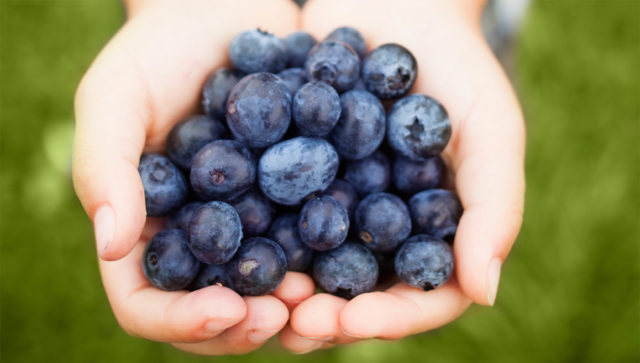Here are some common North American goodies that are safe to eat if you find yourself stuck in the wild:
Blackberries:

Many wild berries are not safe to eat, it’s best to stay away from them. But wild blackberries are 100% safe to eat and easy to recognize. They have red branches that have long thorns similar to a rose, the green leaves are wide and jagged. They are best to find in the spring when their white flowers bloom, they are clustered all around the bush and their flowers have 5 points. The berries ripen around August to September.
Dandelions:

The easiest to recognize is the dandelion, in the spring they show their bright yellow buds. You can eat the entire thing raw or cook them to take away the bitterness, usually in the spring they are less bitter. They are packed with Vitamin A and Vitamin C, and beta carotene.
Asparagus:

The vegetable that makes your pee smell funny grows in the wild in most of Europe and parts of North Africa, West Asia, and North America. Wild asparagus has a much thinner stalk than the grocery-store variety. It’s a great source of source of vitamin C, thiamine, potassium and vitamin B6. Eat it raw or boil it like you would your asparagus at home.
Elderberries:

An elderberry shrub can grow easily grow about 10 feet and yield tons of food, their leaf structure is usually 7 main leaves on a long stretched out stem, the leaves are long and round and the leaves themselves have jagged edges. These are easiest to identify in the spring as they blossom white clustered flowers that resembles an umbrella. Mark the spot and harvest the berries when they’re ripe around September.
Elderberries are known for their flu and cold healing properties, you can make jelly from them and are very sweet and delicious.
Gooseberries:

These are also common in the woods in northern Missouri, the branches are grey and have long red thorns, and the leaves are bright green and have 5 points, they have rounded edges and look similar to the shape of a maple leaf. The flowers in the spring are very odd looking, they are bright red and hang down, the berries ripen around late May early June.
Mulberries:

Mulberry leaves have two types, one spade shape and a 5 fingered leaf. Both have pointed edges.
Pine:

There are over a hundred different species of pine. Not only can the food be used as a supply of nourishment but, also can be used for medicinal purposes. Simmer a bowl of water and add some pine needles to make tea. Native americans used to ground up pine to cure skurvy, its rich in vitamin C.
Kudzu:

Pretty much the entire plant is edible and is also known for medicinal values. The leaves can be eaten raw, steam or boiled. The root can be eaten as well. (like all herbs, pregnant women and breast-feeding woman should consult a physician first before use)
Daylily:

You can find this plant in many parts of the country, These are not tigerlilies or easterlilies (which are toxic), a daylily is completely safe to eat. Daylilies have bright orange flowers that come straight out of the ground, their main stock/stem has no leaves so that’s your confirmation that it’s a day lily, if you see an orange six-petal flower like this one that has a bear stem (no leaves) it’s a daylily. You can eat them whole or cook them or put them in salads.
Pecans:

The trees mature around 20-30 ft, some can grow up to 100 ft tall. The leaves are bright green and long, smooth edges and the pecans themselves are grown in green pods and when ripe the pods open and the seeds fall to the ground.
Hazelnuts:

Hazelnut trees are short and tend to be around 12-20 ft tall, the leaves are bright green and have pointed edges, the hazelnuts themselves grown in long strands of pods and generally ripen by September and October.
Walnuts:

Walnut trees are the most recognizable and the tallest nut tree in North America, they can range from 30-130 feet tall. The leaf structure is very similar to the pecan, the leaves are spear like and grow on a long stem 6-8 leaves on both sides. The leaves edges are smooth and green. The walnuts tend to grow in clusters and ripen in the fall.
[Related article: Study: Walnuts Reduce Diabetes Risk By Almost 25 Percent ]
Acorns:

Acorns can tend to be bitter, they are highly recognizable as well, they should be eaten cooked and a limited amount.
Hickory Nuts:

Hickory nut trees can grow about 50-60 ft tall, their green leaves are spear like and can grow very large, they have pointed edges. The hickory nut is round and ten to ripen in September or October.
Cattail:

Known as cattails or punks in North America and bulrush and reedmace in England, the typha genus of plants is usually found near the edges of freshwater wetlands. Cattails were a staple in the diet of many Native American tribes. Most of a cattail is edible. You can boil or eat raw the rootstock, or rhizomes, of the plant. The rootstock is usually found underground. Make sure to wash off all the mud. The best part of the stem is near the bottom where the plant is mainly white. Either boil or eat the stem raw. Boil the leaves like you would spinach.
Garlic Mustard:

Edible parts: Flowers, leaves, roots and seeds. Leaves can be eaten in any season, when the weather gets hot, the leaves will have a taste bitter. Flowers can be chopped and tossed into salads. The roots can be collected in early spring and again in late fall, when no flower stalks are present. Garlic mustard roots taste very spicy somewhat like horseradish…. yummy! In the fall the seed can be collected and eaten.
Chickweed:

These usually appear May and July, you can eat the leaves raw or boiled, they’re high in vitamins and minerals! (pregnant women and breast-feeding woman should consult a physician first before use)
Herb Robert

Edible parts: The entire plant. Fresh leaves can be used in salads or to make tea. The flower, leaves and root can be dried and stored using it later as a tea or herbs as a nutrient booster. Rubbing fresh leaves on the skin is known to repel mosquitoes, and the entire plant repels rabbits and deer which would compliment and protect your garden. (like all herbs, pregnant women and breast-feeding woman should consult a physician first before use)
Beach Lovage:

Use the leaves raw in salads or salsas, or cooked in soups, with rice, or in mixed cooked greens. Beach lovage can have a strong flavor and is best used as a seasoning, like parsley, rather than eaten on its own. Beach lovage tastes best before flowers appear, and is also called Scotch lovage, sea lovage, wild celery, and petrushki.
Plantain:

Is another one of those plants that seems to thrive right on the edge of gardens and driveways, but it’s also edible. Pick the green, rippled leaves and leave the tall flower stems. Blanch the leaves and sauté with some butter and garlic just as you would with kale or any other tough green.
Garlic Grass:

Garlic grass (Allium vineale or wild garlic) is an herbal treat often found lurking in fields, pastures, forests and disturbed soil. It resembles cultivated garlic or spring onions, but the shoots are often very thin. Use it in sandwiches, salads, pesto or chopped on main courses like scallions.
Watercress:

Cresses (Garden cress, water cress, rock cress, pepper cress) are leafy greens long cultivated in much of Northern Europe. They have a spicy tang and are great in salads, sandwiches, and soups.
Lamb’s Quarters:

Use the leaves raw in salads, or cooked in soups, in mixed cooked greens, or in any dish that calls for cooking greens. Lamb’s Quarters are susceptible to leaf miners; be careful to harvest plants that are not infested. Although Lamb’s Quarters are best before the flowers appear, if the fresh young tips are continuously harvested, lamb’s quarters can be eaten all summer. Lamb’s Quarters is also called Pigweed, Fat Hen, and Goosefoot.
Goose Tongue:

Use the young leaves raw in salads, or cooked in soups, in mixed cooked greens, or in any dish that calls for cooking greens. Goosetongue is best in spring and early summer, before the flowers appear. Goosetongue can be confused with poisonous Arrowgrass, so careful identification is essential. Goosetongue is also called Seashore Plantain.
Pigweed:

Edible parts: The whole plant – leaves, roots, stem, seeds. The Amaranth seed is small and very nutritious and easy to harvest, the seed grain is used to make flour for baking uses. Roasting the seeds can enhance the flavor, also you can sprout the raw seeds using them in salads, and in sandwiches, etc. Young leaves can be eaten raw or cooked like spinach, sautéed, etc. Fresh or dried pigweed leaves can be used to make tea.
Monkey Flower:

Use the leaves raw in salads, or cooked in soups, mixed cooked greens, or any dish that calls for cooking greens. Monkey flower is best before the flowers appear, although the flowers are also edible and are good in salads or as a garnish.
“Self-Heal” Prunella vulgaris:

Edible parts: the young leaves and stems can be eaten raw in salads; the whole plant can be boiled and eaten as a potherb; and the aerial parts of the plant can be powdered and brewed in a cold infusion to make a tasty beverage. The plant contains vitamins A, C, and K, as well as flavonoids and rutin. Medicinally, the whole plant is poulticed onto wounds to promote healing. A mouthwash made from an infusion of the whole plant can be used to treat sore throats, thrush and gum infections. Internally, a tea can be used to treat diarrhea and internal bleeding. (like all herbs, pregnant women and breast-feeding woman should consult a physician first before use)
Mallow Malva neglecta:

Edible parts:All parts of the mallow plant are edible — the leaves, the stems, the flowers, the seeds, and the roots (it’s from the roots that cousin Althaea gives the sap that was used for marshmallows). Because it’s a weed that grows plentifully in neglected areas, mallows have been used throughout history as a survival food during times of crop failure or war. Mallows are high in mucilage, a sticky substance that gives them a slightly slimy texture, similar to okra, great in soups. Mallow has a nice pleasant nutty flavor. One of the most popular uses of mallows is as a salad green. (like all herbs, pregnant women and breast-feeding woman should consult a physician first before use)
Miner’s Lettuce:

Parts: Flowers, Leaves, Root. Leaves can be eaten raw or cooked. A fairly bland flavor with a mucilaginous texture, it is quite nice in a salad. The young leaves are best, older leaves can turn bitter especially in the summer and if the plant is growing in a hot dry position. Although individual leaves are fairly small, they are produced in abundance and are easily picked. Stalks and flowers can be eaten raw. A nice addition to the salad bowl. Bulb also can be eaten raw. Although very small and labor-intensive to harvest, the boiled and peeled root has the flavor of chestnuts. Another report says that the plant has a fibrous root system so this report seems to be erroneous.
Sweet Rocket (Hesperis matronalis)

This plant is often mistaken for Phlox. Phlox has five petals, Dame’s Rocket has just four. The flowers, which resemble phlox, are deep lavender, and sometimes pink to white. The plant is part of the mustard family, which also includes radishes, broccoli, cabbage, cauliflower, and, mustard. The plant and flowers are edible, but fairly bitter. The flowers are attractive added to green salads. The young leaves can also be added to your salad greens (for culinary purposes, the leaves should be picked before the plant flowers). The seed can also be sprouted and added to salads. NOTE: It is not the same variety as the herb commonly called Rocket, which is used as a green in salads.
Wild Bee Balm:

Edible parts: Leaves boiled for tea, used for seasoning, chewed raw or dried; flowers edible. Wild bee balm tastes like oregano and mint. The taste of bee balm is reminiscent of citrus with soft mingling of lemon and orange. The red flowers have a minty flavor. Any place you use oregano, you can use bee balm blossoms. The leaves and flower petals can also be used in both fruit and regular salads. The leaves taste like the main ingredient in Earl Gray Tea and can be used as a substitute.
Mallow:

Mallow is a soft tasty leaf good in fresh salads. Use it like lettuce and other leafy greens. You may find the smaller younger leaves a tad more tender. Toss in salads, or cook as you would other tender greens like spinach. The larger leave can be used for stuffing, like grape leaves. The seed pods are also edible while green and soft before they harden, later turning woody and brown. I hear they can be cooked like a vegetable. I’ve harvested and eaten them raw, and want to try steaming, pickling, fermenting, and preparing like ocra.
Pineapple Weed:

Edible parts: Pineapple weed flowers and leaves are a tasty finger food while hiking or toss in salads. Flowers can also be dried out and crushed so that it can be used as flour. As with chamomile, pineapple weed is very good as a tea. Native Americans used a leaf infusion (medicine prepared by steeping flower or leaves in a liquid without boiling) for stomach gas pains and as a laxative.
Milk Thistle:

Milk thistle is most commonly sought for its medicial properties of preventing and repairing liver damage. But most parts of the plants are also edible and tasty. Until recently, it was commonly cultivated in Eurpoean vegetable gardens. Leaves can be de-spined for use as salad greens or sautéed like collard greens; water-soaked stems prepared like asparugus; roots boiled or baked; flower pods used like artichoke heads.
[Related: Health Benefits of Milk Thistle ]
Prickly Pear Cactus:

Found in the deserts of North America, the prickly pear cactus is a very tasty and nutritional plant that can help you survive the next time you’re stranded in the desert. The fruit of the prickly pear cactus looks like a red or purplish pear. Hence the name. Before eating the plant, carefully remove the small spines on the outer skin or else it will feel like you’re swallowing a porcupine. You can also eat the young stem of the prickly pear cactus. It’s best to boil the stems before eating.







